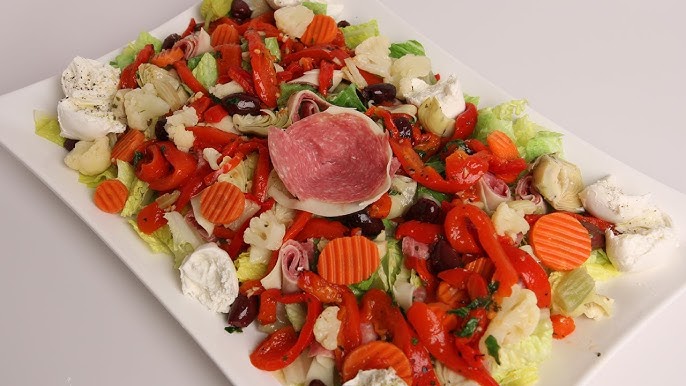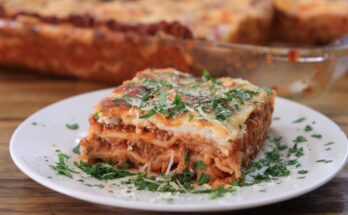Antipasto Salad Recipe: Let’s start by decoding the name. “Antipasto” is an Italian word that means “before the meal.” It refers to the traditional first course of an Italian dinner, which usually consists of cured meats, cheeses, olives, pickled vegetables, and sometimes seafood. While the original form is served platter-style, in recent years it has beautifully evolved into a chopped or tossed salad format. The modern Antipasto Salad captures all the bold, briny, and savory flavors of a traditional antipasto platter but wraps them up into a refreshing, easy-to-eat salad form.
What makes this salad special? It’s not your average bowl of greens. It’s a flavor-packed combination of protein, fat, and veggies – and honestly, it’s hard to beat. Whether you’re throwing a summer cookout, prepping a weeknight dinner, or setting up a weekend lunch spread, this salad is guaranteed to impress. It looks fancy, tastes gourmet, and takes minimal effort. That’s a win-win-win!
Origins and Cultural Significance
The antipasto tradition dates back centuries and plays a huge role in Italy’s food culture. Before pasta dishes took over the table, antipasto was the way to welcome guests and get the appetite going. It’s not just about eating – it’s a social ritual. Guests gather around, sip some wine, nibble on meats and cheeses, and talk. It’s casual, relaxed, and so very Italian.
Bringing that tradition into your kitchen with an antipasto salad lets you enjoy those same vibes but in a practical way. No need for multiple dishes or a formal setup. You toss everything together and boom – all those flavors in one big beautiful bowl. Think of it as the best parts of a charcuterie board turned into a meal.
Essential Ingredients for Antipasto Salad
The magic of an antipasto salad lies in the balance. Salty meats, creamy cheeses, briny veggies, and a punchy vinaigrette – all dancing together in every bite. Here’s a breakdown of the key ingredients:
Meats – Salami, Prosciutto & More
Cured meats are the soul of any antipasto dish. For a salad, you want a good mix of flavors and textures. Here are some of the go-to options:
- Genoa Salami – Mildly spicy and rich in fat.
- Prosciutto – Thinly sliced and melt-in-your-mouth tender.
- Capicola – A bit peppery, great for a flavor kick.
- Pepperoni or Soppressata – For a bold, spicy edge.
You don’t need all of them, but a combination of two or three adds depth. Try folding or rolling them before adding to the salad to make the presentation pop!
Cheeses – Mozzarella, Provolone, Parmesan
No antipasto is complete without cheese, and this salad is no different. Choose a mix of soft and hard cheeses for contrast:
- Fresh Mozzarella Balls (Ciliegine) – Mild, creamy, and perfect for texture.
- Provolone Cubes – A bit sharper and drier, adds a nice bite.
- Parmesan Shavings – Salty and nutty, the ultimate flavor booster.
If you’re feeling fancy, go with marinated mozzarella or smoked provolone. It’ll elevate the salad without much effort.
Vegetables – Olives, Artichokes, Roasted Peppers
Here’s where the salad gets its signature tang and color. These veggies are usually jarred or canned, which makes things super easy.
- Kalamata Olives – Deep, briny, and slightly fruity.
- Green Olives with Pimento – For a milder, classic olive flavor.
- Artichoke Hearts – Tender and tangy, best when marinated.
- Roasted Red Peppers – Sweet and smoky, great for balancing salty ingredients.
- Cherry Tomatoes – Fresh and juicy, they add the perfect pop of sweetness.
You can also throw in some red onions, banana peppers, or even sun-dried tomatoes if you like a stronger flavor.
Dressing – The Flavor Maker
A zesty vinaigrette ties the whole salad together. Store-bought is fine, but homemade makes a noticeable difference. Here’s a simple version:
- 1/2 cup olive oil
- 1/4 cup red wine vinegar
- 1 tsp Dijon mustard
- 1 garlic clove, minced
- 1 tsp Italian seasoning
- Salt & black pepper to taste
Whisk it up and pour generously. The vinegar brightens up the rich meats and cheeses, while the herbs give it that rustic Italian flavor.
Tools You’ll Need to Make Antipasto Salad
Before you dive into your kitchen adventure, make sure you’ve got the right tools on hand. You don’t need a high-tech kitchen or anything fancy, just a few basics that make the process smooth and fun.
- Large Mixing Bowl – This is where the magic happens. Go for a big, wide bowl so you can toss everything easily without spilling.
- Sharp Chef’s Knife – You’ll be chopping meats, slicing cheeses, and prepping veggies. A good, sharp knife will make this faster and safer.
- Cutting Board – Use a clean, sturdy cutting board. If possible, have separate boards for meat and vegetables to avoid cross-contamination.
- Measuring Cups & Spoons – Essential for mixing your vinaigrette and seasoning correctly.
- Whisk or Jar with Lid – For blending your dressing. A whisk gives you control, but shaking it up in a mason jar is easy and mess-free.
- Tongs or Salad Servers – For tossing everything together without smashing your ingredients.
- Storage Containers – If you’re meal prepping or planning to store leftovers, airtight containers are a must.
Having these tools ready not only saves time but also helps you stay organized and stress-free while making your salad.
Step-by-Step Instructions to Make Antipasto Salad
Step 1 – Prepare Your Ingredients
First thing’s first—lay out all your ingredients. Drain and rinse your canned or jarred items like olives and artichoke hearts. Pat them dry with a paper towel to prevent extra moisture from watering down your salad. If you’re using marinated veggies, don’t rinse them—just let the excess oil drip off.
Slice your meats into bite-sized strips or squares. Roll up prosciutto into little bundles or fold salami into half-moons. It looks great and makes each bite balanced. For cheese, cut into cubes or use small mozzarella balls. Shave or grate Parmesan for a finishing touch.
Vegetables like cherry tomatoes should be halved, roasted peppers sliced into strips, and onions cut thinly for better flavor blending.
Preparation is key here. Think of this like building blocks—each ingredient should be prepped in a way that it shines in every forkful.
Step 2 – Chop, Slice, and Dice Like a Pro
Now that you’ve gathered everything, it’s time to chop and slice. You want every ingredient to be roughly the same size for easy eating and even distribution. No one likes getting a bite that’s all cheese and no veggies, right?
Here’s a quick guide:
- Meats – 1-inch pieces or thin strips.
- Cheeses – Cubes or small balls.
- Olives and Tomatoes – Halved or sliced.
- Artichokes and Peppers – Bite-sized chunks.
- Onions – Super thin slices.
As you prep, keep aesthetics in mind too. This salad is colorful, and the more vibrant it looks, the more appetizing it will be. Think reds from peppers and tomatoes, greens from olives and herbs, creamy whites from cheese, and pinks from the meats. A real rainbow of flavor!
Step 3 – Mix and Toss with Love
This step is where everything comes together. Place all your prepared ingredients into a large mixing bowl. If you’re making it ahead of time, you can hold off on the dressing. Otherwise, drizzle on your vinaigrette and gently toss everything to coat evenly.
Don’t overdo the tossing—especially if you’re using delicate ingredients like mozzarella balls or roasted peppers. You want everything well mixed, but not squished.
Take a moment to smell the mix. That blend of herbs, vinegar, meats, and veggies? That’s the soul of your salad.
Add a bit of freshly ground pepper or a sprinkle of sea salt at this point if you want to boost the flavor. Just be cautious—many ingredients are salty on their own.
Step 4 – Add Dressing and Chill
Once everything is combined, let it rest. You heard me—this salad actually gets better if you give it a bit of time. Cover the bowl with plastic wrap or lid and refrigerate it for at least 30 minutes before serving. This allows the flavors to mingle and soak into each other.
When you’re ready to serve, give it one last gentle toss. Taste and adjust seasoning if needed. Maybe a little extra vinaigrette or a dash of lemon juice to brighten it up? Go for it!
If you’re taking it to a party or picnic, pack the dressing separately and mix right before serving to keep everything fresh.
Serving Suggestions and Pairings
Perfect Occasions for Antipasto Salad
This salad is a multitasker—it can be a side dish, a main course, or even a potluck star. Here are a few scenarios where it really shines:
- Family BBQs – Cuts through the richness of grilled meats.
- Holiday Tables – Adds a splash of color and an Italian touch.
- Weeknight Dinners – Quick, no-cook, and satisfying.
- Lunch Meal Prep – Keeps well and doesn’t wilt like leafy greens.
- Picnics and Potlucks – Easy to pack and guaranteed to disappear.
It’s also great when you’re feeding a crowd. You can double or triple the recipe without much extra effort. Just keep the dressing separate and toss before serving.
Wine and Bread Pairings
Want to make your meal feel extra fancy? Pair your antipasto salad with a glass of crisp white wine—something like a Pinot Grigio or Sauvignon Blanc. If you prefer reds, a light Chianti or Zinfandel complements the rich meats and cheese beautifully.
Bread-wise, you can’t go wrong with:
- Crusty Italian Bread – For mopping up that vinaigrette.
- Garlic Crostini – Adds crunch and flavor.
- Breadsticks (Grissini) – A fun, crispy option.
Serve everything together and you’ve got yourself a restaurant-worthy experience right at home.
Storage Tips and Make-Ahead Advice
If you’re a fan of prepping meals ahead of time—or if you just want to make your busy life easier—antipasto salad is your friend. This dish not only stores well but often tastes even better after sitting in the fridge for a few hours.
How to Store It Properly
- Refrigeration: Store your antipasto salad in an airtight container. It will stay fresh for about 3 to 4 days. Because it’s made with cured meats and firm cheeses, it doesn’t wilt or break down as fast as leafy green salads.
- Keep Dressing Separate: If you’re planning to store the salad for more than a day, it’s best to store the dressing separately. This prevents the salad from becoming soggy and helps preserve the texture.
- Freezing: Not recommended. The ingredients, especially fresh mozzarella and vegetables like tomatoes or artichokes, won’t hold up well to freezing. The texture changes and you’ll lose that fresh, vibrant crunch.
Make-Ahead Tips
Want to make your salad the day before a party or dinner? No problem!
- Prep in Layers: Layer the salad in a bowl or storage container with the hearty items on the bottom (meats, artichokes, olives), and delicate ones like mozzarella and tomatoes on top. Toss everything together with dressing right before serving.
- Dressing Tip: Make the vinaigrette ahead and store it in a mason jar. Shake it well just before pouring to re-emulsify the oil and vinegar.
This approach keeps everything fresh, saves you time on the day of serving, and still delivers big, bold flavor.
Common Mistakes to Avoid
Even though antipasto salad is pretty foolproof, a few simple mistakes can mess up the flavor or texture. Let’s keep you on the path to salad success:
1. Using Low-Quality Ingredients
This salad is all about the ingredients, so don’t skimp. Use good-quality salami, fresh mozzarella, and authentic olives. Trust me, you’ll taste the difference. Since there’s no cooking involved, each ingredient stands out.
2. Overdressing the Salad
Too much dressing can overwhelm the delicate balance of flavors and make the salad greasy. Start with a small amount and add more as needed. You want the ingredients coated, not drowned.
3. Not Drying Ingredients
Jarred veggies like olives and artichokes often come packed in oil or brine. If you toss them in without draining and drying, your salad can turn soggy. A quick pat-down with a paper towel goes a long way.
4. Skipping the Chill Time
Rushing to serve right after tossing? You’ll miss out. Chilling the salad for at least 30 minutes helps the flavors blend and makes each bite more cohesive. Plus, cold antipasto just tastes better.
5. Poor Presentation
It’s a small thing, but it matters. Take a moment to arrange your meats and cheeses attractively. A little effort in presentation turns your salad from “eh” to “wow.”
Avoiding these common pitfalls ensures that your antipasto salad comes out perfect every time—balanced, fresh, and totally irresistible.
Variations and Customizations
One of the best things about antipasto salad? It’s endlessly customizable. You can adjust it based on your dietary needs, preferences, or just what’s in your fridge.
Vegetarian Antipasto Salad
Cutting out meat? No problem! You can still enjoy all the rich, tangy flavors.
Meat Alternatives:
- Grilled or Roasted Tofu – Marinate it in Italian herbs for added depth.
- Chickpeas or White Beans – Add protein and texture.
- Marinated Mushrooms – For that earthy, umami bite.
Stick with cheeses, olives, roasted peppers, cherry tomatoes, and artichoke hearts. Top it off with a zesty vinaigrette, and you’ve got a meatless masterpiece.
Keto-Friendly Antipasto Bowl
Watching your carbs? Turn this salad into a keto-friendly bowl by skipping high-carb ingredients like croutons or certain beans and focusing on protein and fats.
Keto-Approved Additions:
- Extra salami, pepperoni, and cheese.
- Avocados for healthy fats.
- Olives and pickles for flavor without carbs.
- Leafy greens like arugula or spinach for a base.
Use olive oil and vinegar-based dressing with no added sugars, and you’ve got yourself a filling, keto-approved dish that doesn’t compromise on taste.
Other Fun Twists:
- Tex-Mex Antipasto: Swap in jalapeños, pepper jack cheese, and spiced chorizo.
- Greek-Inspired: Add feta, cucumbers, and a lemon-oregano vinaigrette.
- Seafood Style: Throw in some tuna, anchovies, or grilled shrimp for a Mediterranean twist.
The possibilities are endless. Don’t be afraid to get creative—your taste buds will thank you.
FAQs about Antipasto Salad Recipe
1. What is an antipasto salad?
An antipasto salad is a hearty Italian-inspired dish made with cured meats, cheeses, olives, vegetables, and a zesty vinaigrette dressing. It’s often served as a starter but can also be enjoyed as a main course.
2. What are the best meats for antipasto salad?
Popular choices include salami, prosciutto, pepperoni, and capicola. You can mix and match based on your preference or what you have on hand.
3. What kind of cheese should I use?
Mozzarella (fresh or pearls), provolone, and parmesan are classic options. You can also add cubed cheddar or gouda for a modern twist.
4. Can I make antipasto salad in advance?
Yes! You can prepare it up to a day ahead. Just store the dressing separately and toss it with the salad right before serving to keep it fresh.
5. Is antipasto salad keto-friendly?
Absolutely. It’s low in carbs and high in healthy fats and protein, making it perfect for a keto diet—just skip any croutons or bread on the side.
6. How do I store leftovers?
Place leftovers in an airtight container and refrigerate for up to 3 days. Avoid freezing, as the texture of some ingredients may change.
7. Can I use store-bought dressing?
Yes, but homemade Italian vinaigrette or balsamic dressing gives the best flavor and freshness. It’s quick to whisk together using pantry staples.
Conclusion
Antipasto salad is more than just a dish—it’s an experience. It brings together bold flavors, rich textures, and colorful ingredients to create a meal that feels special, yet is easy enough for any night of the week. Whether you’re serving it at a family gathering or packing it up for weekday lunches, it’s guaranteed to impress.
The best part? You don’t need to be a professional chef to make it shine. With a few fresh ingredients, a little prep, and a good vinaigrette, you’re all set.
So next time you’re craving something hearty, healthy, and packed with flavor, give this antipasto salad recipe a go. It’s a dish that always delivers.



